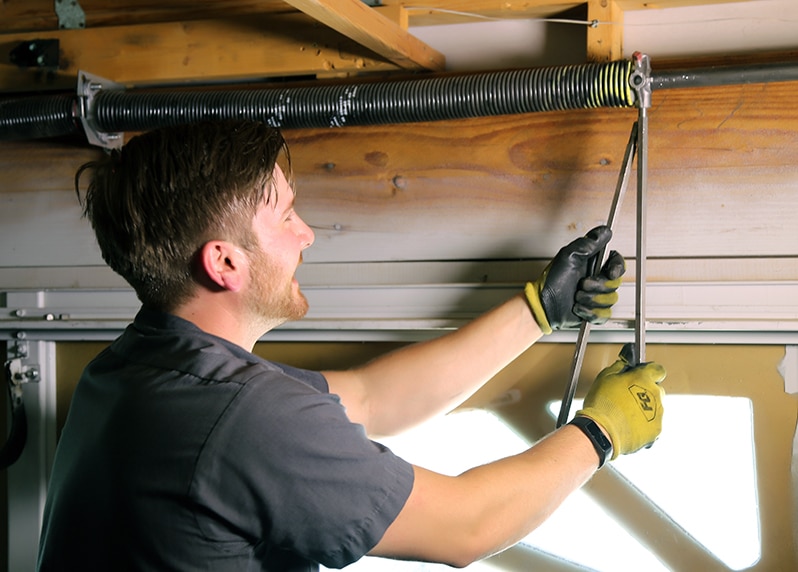
How To Repair Garage Door Springs?
Garage door springs play a vital role in the smooth operation of your garage door, making them an essential component of any garage door system. They bear the door’s weight, allowing it to open and close effortlessly. However, like any mechanical part, garage door springs are subject to wear and tear over time.
A broken or worn-out spring can cause significant inconvenience and, in some cases, be hazardous. Understanding how to repair garage door springs can save you time and money, but it’s also crucial to recognize when to call in a professional. This comprehensive guide will walk you through the steps for DIY repairs and highlight scenarios where a garage door repair specialist’s expertise is necessary.
Part 1: DIY Garage Door Spring Repairs

Types of Garage Door Springs
Before attempting any repairs, it’s essential to identify the type of garage door spring your door uses. There are two primary types:
- Torsion Springs: Torsion springs are tightly coiled above the door and provide significant force.
- Extension Springs: Found on either side of the door, extension springs stretch and contract to move the door.
Safety Precautions
Repairing garage door springs can be dangerous due to the high tension they are under. Always follow these safety precautions:
- Wear Safety Gear: Use safety glasses and gloves.
- Disconnect the Opener: Unplug the garage door opener to prevent accidental activation.
- Use Proper Tools: Ensure you have the right tools for the job, including winding bars for torsion springs.
Steps for DIY Repairs
- Inspect the Springs:
- Check for signs of wear, rust, or breaks.
- If a spring is broken, it will need to be replaced.
- Lubricate the Springs:
- Apply a garage door lubricant to reduce friction and wear.
- Lubricate all moving parts, including hinges, rollers, and tracks.
- Adjusting Torsion Springs:
- Gather Tools: You’ll need winding bars, a wrench, and a ladder.
- Locate the Set Screws: These are on the winding cone at the end of the spring.
- Insert Winding Bars: Insert one winding bar into the winding cone.
- Loosen Set Screws: Carefully loosen the set screws with a wrench.
- Adjust Tension: Use the winding bars to add or release tension. Turn the bar in 1/4-turn increments.
- Tighten Set Screws: Once the desired tension is achieved, tighten the set screws securely.
- Replacing Extension Springs:
- Measure the Spring: Measure the length and diameter of the spring.
- Release Tension: Open the garage door fully to release spring tension.
- Disconnect the Safety Cables: Remove the safety cables from the springs.
- Remove the Old Spring: Disconnect the spring from the brackets and pulleys.
- Install the New Spring: Attach the new spring to the brackets and pulleys, ensuring it is secure.
- Reconnect Safety Cables: Reattach the safety cables to the new spring.
Part 2: When to Call a Garage Door Repair Specialist
While homeowners can handle some garage door spring repairs, certain situations require the expertise of a professional. Here are scenarios where you should call a garage door repair specialist:
Broken Torsion Springs
Torsion springs are under extreme tension; attempting to replace them without proper knowledge and tools can be hazardous. A professional should replace a broken torsion spring to ensure safety and correct installation.
Multiple Springs
If your garage door uses more than one spring and one breaks, it’s advisable to replace all the springs simultaneously. A specialist should handle this complex task to ensure a balanced operation.
Lack of Experience
If you lack experience or confidence in handling garage door spring repairs, it’s best to leave it to the professionals. Mistakes can lead to injury or further damage to the door.
Custom or Unique Garage Doors
Custom or uniquely designed garage doors may have specific spring systems that require specialized knowledge. A professional will have the expertise to handle these unique systems.
Preventative Maintenance
Regular maintenance by a professional can prevent major issues and prolong the life of your garage door springs. A specialist can identify potential problems and fix them before they escalate.
FAQ
1. How often should I inspect my garage door springs?
Inspecting your garage door springs every six months for signs of wear and tear is recommended. Regular inspections can help identify issues early and prevent major problems.
2. What are the signs that my garage door springs need repair?
Common signs include difficulty opening or closing the door, uneven movement, loud noises during operation, and visible gaps or rust on the springs.
3. Can I use any lubricant for my garage door springs?
No, it’s best to use a garage door-specific lubricant. These lubricants reduce friction and wear on the springs and other moving parts.
4. Is it safe to repair garage door springs by myself?
While homeowners can do minor repairs and maintenance tasks, significant repairs, especially torsion springs, can be dangerous and best handled by professionals.
5. How long do garage door springs typically last?
Garage door springs usually last 7-9 years, depending on usage and maintenance. Regular maintenance can extend their lifespan.
6. Why is it important to replace both springs if only one is broken?
Replacing both springs ensures balanced operation. If only one spring is replaced, the older spring may break soon after, causing additional inconvenience and potential damage to the door.
7. Can I convert my extension springs to torsion springs?
Yes, but this is a complex process that a professional should perform. Torsion springs generally offer better performance and durability.
8. How much does it cost to replace garage door springs?
The cost varies depending on the type of springs and labor involved. A professional replacement can range from $150 to $350 on average.
Conclusion
In conclusion, garage door springs are an essential component that ensures the smooth operation of your garage door. While some maintenance tasks, like lubrication and minor adjustments, can be handled by a diligent homeowner, more significant repairs and replacements should be left to the experts. Safety should always be your top priority when dealing with high-tension springs.
Recognizing when to call a professional can prevent injury and damage to your garage door system. Regular maintenance and timely repairs will extend your springs’ lifespan and keep your garage door functioning safely and efficiently. By following this guide, you can confidently tackle minor repairs yourself and know when it’s time to seek professional assistance, ensuring the longevity and reliability of your garage door.



